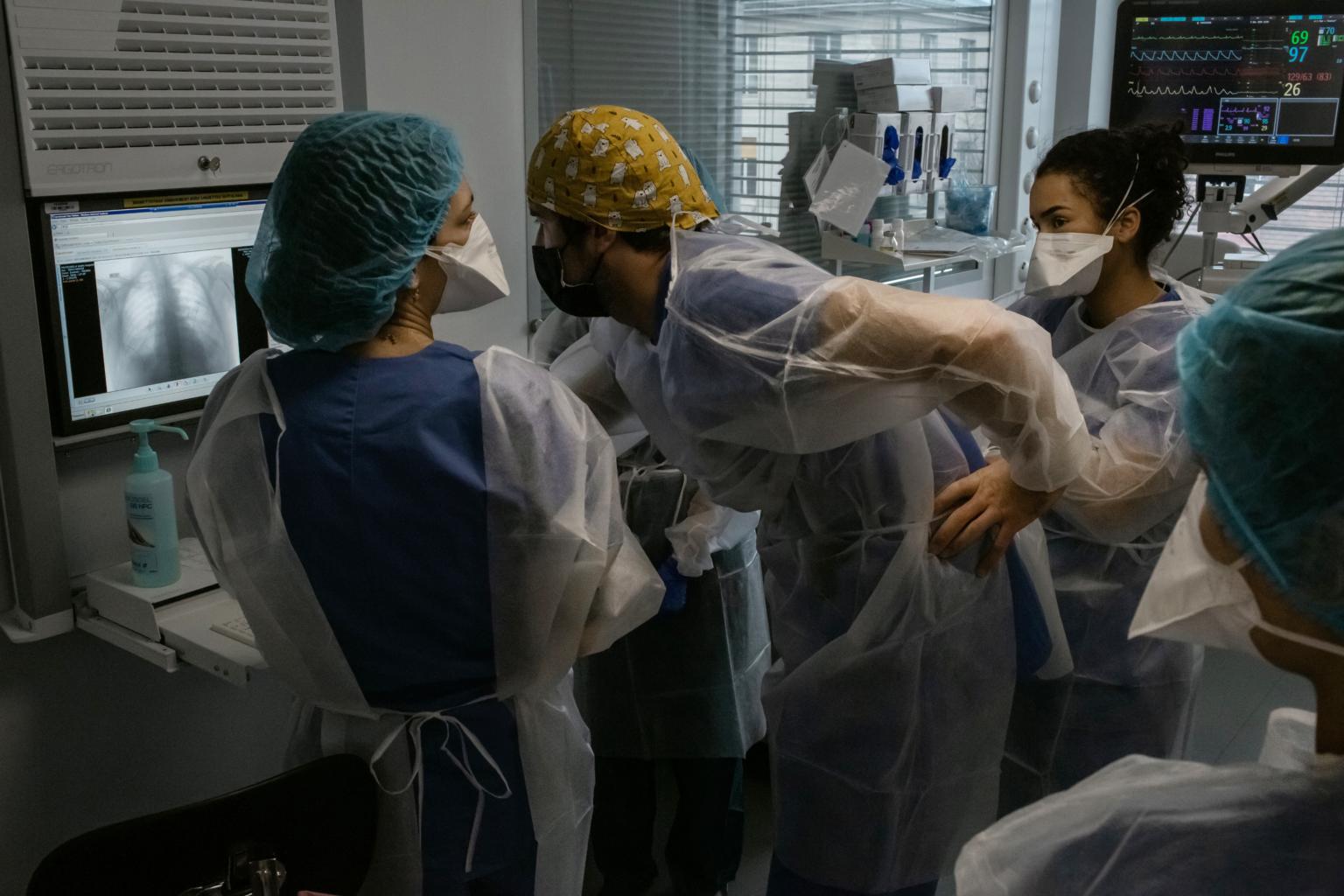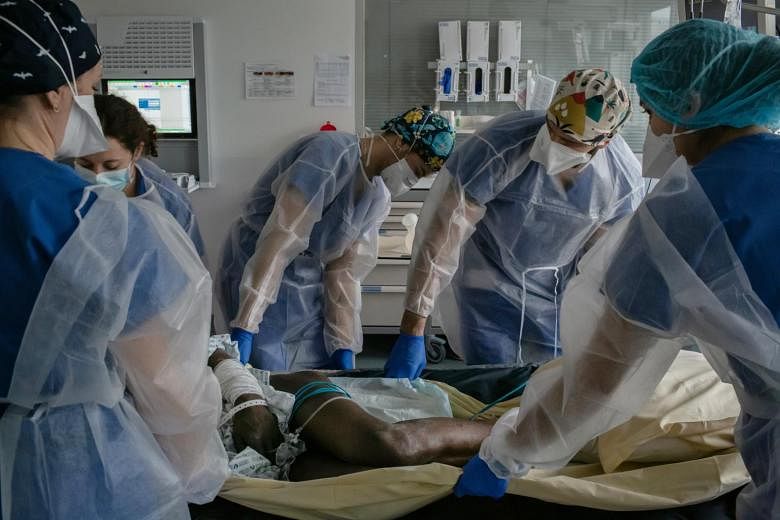BRUSSELS (NYTIMES) - The coronavirus first smashed into Europe with a wave of infections that nearly broke its hospitals - exhausting, infecting and killing doctors and nurses. Lockdowns created some space in intensive care wards over the summer. But the reprieve was short-lived.
Since the fall, the Continent has watched with horror, and paralysis, as another wave struck with nearly equal force - and in some places far more. Hospital corridors were crammed again, respirators overloaded. As death rates spiked, governments imposed new, though watered-down, restrictions, hoping to salvage their economies while keeping the virus at bay.
It hasn't worked out that way. By December, the graphs charting the pandemic's course looked less like progress than a scary roller coaster. It's been that kind of year.
The one constant through it all has been the strain on frontline workers in hospitals who have borne greater risks than most, helped heal the sick, and pulled innumerable, infected patients back from the brink of death.
It has not helped them that Europe's leaders are still struggling to get a handle on a pandemic that has eluded all their policy prescriptions. If any further reminder were needed, President Emmanuel Macron himself tested positive for the coronavirus this week.
In Germany, Chancellor Angela Merkel has closed down much of the country again. Prime Minister Giuseppe Conte of Italy has imposed tough new restrictions over the holidays.
Prime Minister Boris Johnson of Britain, facing a new and fast-spreading variant of the virus, has sealed off London and much of England's south-east and banned Christmas gatherings outside of households. Sweden's king said the country's hands-off approach had "failed."
The dread is pervasive. The already considerable burdens on healthcare workers have actually gotten worse in 30 countries across the Continent in recent weeks, according to the European Centre for Disease Control and Prevention, a European Union agency.
Occupancy and admissions to hospitals and intensive care units were up over the previous week in at least a dozen countries, the agency said in a report on Thursday.
"Transmission is still widespread," it warned.
In France 'it will take time'

Even before Mr Macron's infection, the French government seemed unsure about the wisdom of opening back up. Infection rates failed to fall as quickly as expected, prompting the government to delay the relaxing of some restrictions. Museums, cinemas and theatres will remain closed until at least early January.
In early and mid-November, the resurgence of the virus came close to breaking France's healthcare system. As the country's hospitals registered some 3,000 new Covid-19 patients a day, a number not seen since April, as many as 97 per cent of intensive care beds were occupied with almost 5,000 Covid-19 patients.
That number has since come down to about 2,800 patients occupying less than 60 per cent of those beds, according to figures from the French government. But while there is a sense of a brief reprieve, it is not universal.
The Auvergne-Rhône-Alpes region, which covers central and south-eastern France, has a less developed medical infrastructure than other parts of the country and has been hammered by the second wave. There, 86 per cent of the intensive care beds are still occupied by Covid-19 patients.
Ms Myriam Ladreyt, a nurse in the region, said that the hospital where she worked had only 12 intensive care beds. She used to work in a surgical unit and volunteered to work with coronavirus patients and was astonished by how long people took to recover.
"Some just don't leave," she said.
"The winter season is going to be very hard," said Mr Jerome Salomon, a top official at the French Health Ministry. "It will take time to bring the epidemic under control."
'We killed ourselves' in Italy

The governor of Italy's north-eastern Veneto region, where the first Italian died of Covid, said the region's hospitals were now more overwhelmed with patients than they were in March. One town's hospital morgue had to move out an overload of cadavers.
Nearby, in the wealthy northern Italian region of Lombardy, the situation is almost as alarming. Lombardy is known for its well-equipped hospitals. But the first wave of the virus nearly broke them, as overwhelmed emergency rooms and intensive care units were forced to send patients to other parts of the country and even abroad.
Varese, on the region's northern border, was not spared. But when a national lockdown brought hospitals some relief in the summer, the town's hospitals prepared. They expanded their intensive care capacity, hired more staff, and loaded up on oxygen tanks.
But cases started ticking up in October, with new admissions quickly outpacing the numbers of those who recovered and were discharged.
At the beginning of November, Italy began imposing increasingly tough restrictions to reduce the number of infections and lighten the burden on hospitals. That has begun to pay off.
But about 38 per cent of intensive care beds, and 45 per cent of all hospital beds, are still occupied by coronavirus patients, according to the Italian government. The number of Italians requiring hospitalisation remains high. Such a situation is especially dangerous in Italy's less advantaged south.
In Naples last month, a man with a suspected coronavirus infection died in the bathroom of the Cardarelli hospital's packed emergency room. Nurses distributed oxygen tanks to patients waiting outside in their cars. And doctors served extra shifts to meet the needs of all the Covid patients.
"We killed ourselves," said Dr Alessandro Perrella, an infectious disease doctor in the hospital.
'Very fragile' in the Czech Republic

In the Czech Republic, after several weeks of a steady decline in the number of new coronavirus patients, the numbers started rising again this month, and there are now more than 4,600 people in the country's hospitals. "Very fragile," Dr Jan Blatny, the Czech Republic's health minister, said this month of the situation in the country's hospitals.
Last Wednesday the authorities recorded the steepest daily rise in new cases in the last two weeks, when 8,235 people tested positive. To stem the new tide, the government reimposed severe restrictions, closing restaurants and bars, imposing curfews to stop the movement of people between 11pm and 5am and limiting gatherings both inside and outside to a maximum of six.
For the country's exhausted medical workers, the restrictions couldn't come soon enough.
"We are tired and it seems endless," said Ms Barbora Marcakova, the head nurse of the emergency unit at the Brno University Hospital.
Still 'worrisome' in Spain

The initial outbreak of the virus in the spring caught Spain's hospitals by surprise. Many healthcare workers faced the epidemic without adequate protective gear and tens of thousands were infected. In the hospitals of Madrid, some patients slept in corridors. Altogether Spain's flat-footed reaction undermined the reputation of a public health care system of which many Spanish had been proud.
This autumn, however, doctors and nurses seemed better prepared and the equipment supply chain improved. In part because of demonstrations and work stoppages to protest their low salaries, difficult work conditions, and broken government promises to add more staff, they received the protective gear to keep themselves safe.
But the greatest assistance was perhaps a government crackdown in response to an explosion of new cases between October and November. The restrictions on the movement of people have yielded dramatic improvements in many regions and significantly eased pressure on the country's hospitals.
As of a few days ago, less than 10 per cent of the available hospital beds in Spain - and 21 per cent of the intensive care units - were occupied by coronavirus patients, according to the Health Ministry.
Nevertheless, there has been another uptick in infections since early December and Ms Silvia Calzon, Spain's secretary of state for health, said this month at a news conference that the number of new Covid-19 patients remained "worrisome."
In some regions, the recent improvement has been "spectacular," she said, "but this cannot lead us to relax."











